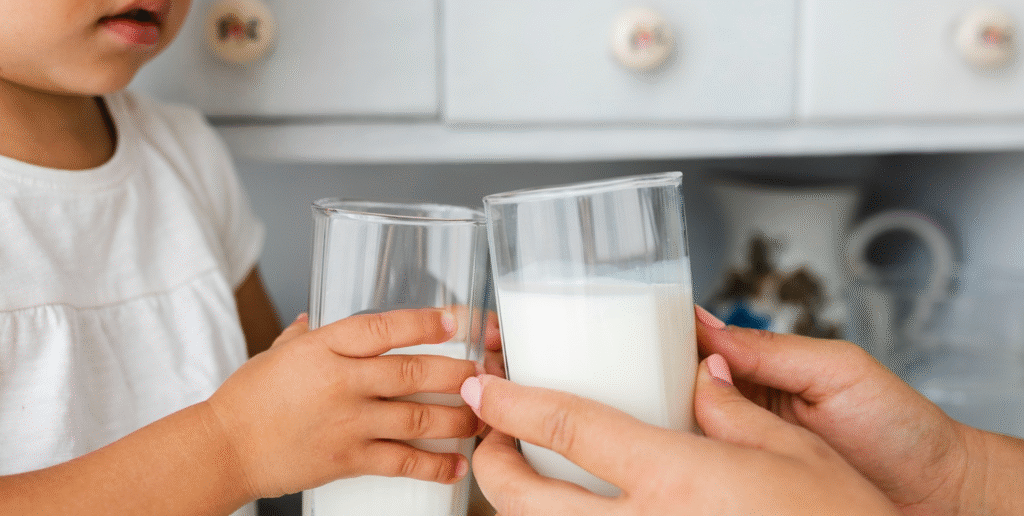Milk isn’t always the first thing that comes to mind when a child starts throwing up after breakfast or complains of stomach cramps. However, dairy is increasingly being identified as the cause of recurring pain and suffering for a growing number of families. Children are increasingly experiencing a range of symptoms shortly after drinking milk, from hives and loose stools to bloating and, in extreme cases, potentially fatal reactions, according to pediatricians. Lactose intolerance is the cause for some people, but for others, it’s a real milk allergy or even tainted dairy products, like raw milk. Although each case is unique, the effects on family life—such as missed school, sleepless nights, and tense ER visits—can be remarkably similar.
As more parents started cooking at home during the pandemic, milk-related health issues started to appear more frequently. Working with public health clinics, researchers found that milk consumption was often mentioned in reports of digestive problems in children between the ages of two and ten. The problem is not limited to a single condition. The enzyme lactase, which is necessary for the breakdown of lactose, is deficient in certain children. Some people have an immunological response to milk proteins, which can result in rashes, swelling, and in rare instances, dangerously low blood pressure. Raw milk, which is frequently marketed as a “natural” substitute, has been connected to bacterial infections that are extremely dangerous for kids’ health.
Common Causes of Milk-Related Illness in Children
| Cause | Description |
|---|---|
| Milk Allergy | An immune response to casein or whey proteins in milk; may cause severe allergic reactions |
| Lactose Intolerance | A digestive condition caused by low lactase enzyme levels, resulting in gas, bloating, and diarrhea |
| Raw Milk Consumption | Risk of contamination with harmful bacteria such as Listeria, E. coli, or Salmonella |
| Spoiled Milk | Improper storage or expired milk can cause nausea, vomiting, and stomach upset |
| Overconsumption | Drinking excessive milk may lead to constipation, stomach cramps, or iron deficiency |
| Reference | Mayo Clinic – Milk Allergy |
Pediatric specialists have determined that milk-related problems rank among the leading causes of recurring gastrointestinal complaints in young children by combining data from electronic health systems. The subtlety of symptoms is what makes diagnosis especially difficult. For example, long before anyone links dairy to a child’s eczema or persistent ear infections, the child may have a milk allergy. In other situations, symptoms, particularly those related to lactose intolerance, may manifest hours after ingestion, which makes it simple to mistake them for behavioral issues or viral infections.
Maintaining a food journal frequently works incredibly well for symptoms in their early stages. It is advised that parents monitor their child’s diet and behavior, noting behavioral changes like irritability or lethargy in addition to physical symptoms like rashes or bloating. This straightforward technique can reveal patterns that lab testing alone might overlook, particularly when combined with a pediatric consultation. Some families have been able to avoid needless drugs, surgeries, or protracted diagnostic delays by using strategic documentation.
Pediatric dietitians have spent the last ten years trying to inform families about the differences between lactose intolerance and milk allergy. Whereas lactose intolerance results from an enzyme deficiency, a milk allergy affects the immune system. Despite their frequent confusion, the two call for quite different management strategies. Children with lactose intolerance benefit greatly from lactase supplements and lactose-free dairy products, which enable them to experience similar flavors and textures without experiencing symptoms. All milk proteins, including those found in baked goods and processed foods that contain hidden dairy ingredients, must be strictly avoided by allergy sufferers.
Concerns regarding raw milk have reappeared in recent months as a result of false information that has gone viral on social media. Food safety experts vehemently disagree with proponents of raw milk’s claims that it is “easier to digest” or “more nutritious.” The CDC has connected raw milk to Listeria and Campylobacter outbreaks by combining surveillance data, with children under five being especially vulnerable. Parents are urged to seek advice from registered dietitians and certified pediatricians because they are overloaded with contradicting recommendations. The appeal of “natural” doesn’t always equate to safety, particularly when it ignores data from science.
Additionally, school lunch programs have drawn criticism. Milk is still regarded by many institutions as an essential component of the daily meal. Rigid policies can backfire, even though the nutritional goals are sound—milk provides calcium and vitamin D. Despite known intolerances, some parents have related how their kids have been made fun of for refusing milk or denied water. Thankfully, some districts have started to provide fortified plant-based or lactose-free options. These adjustments have significantly increased student energy and focus in the classroom in addition to lowering absenteeism.
By promoting dairy-free lifestyles without distinguishing between allergies and personal preference, celebrity wellness influencers have muddied the debate. For instance, when well-known individuals advocate for “cleaner” options like almond or oat milk, some parents may take that as medical advice, which could result in needless limitations or nutritional deficiencies. Pediatric clinics have occasionally been overrun by the trend, as worried parents inquire as to whether their child should avoid dairy “just in case.” Unnecessary restriction can deprive children of vital nutrients during crucial growth phases, even though awareness is unquestionably important.
Parents can make well-informed decisions that are in line with their child’s particular physiology rather than broad trends by speaking with medical professionals. Since the hydrogen breath test is so effective at identifying lactose malabsorption, many pediatricians now advise using it to diagnose lactose intolerance. Similar to this, allergy panels are able to identify particular sensitivities, providing a very clear picture of which foods need to be avoided. Accurate diagnoses typically result in more long-lasting solutions and less emotional toll on families.
Children’s bone health still depends on calcium and vitamin D, especially during growth spurts. Thankfully, families with milk restrictions can choose from a wide variety of options. Leafy greens, tofu, canned salmon with bones, and fortified plant milks can all be dependable sources of calcium. If diet isn’t enough, doctors might suggest supplements based on the child’s age and requirements. Because vitamin D greatly enhances calcium absorption and boosts immune function, it is equally important to make sure you are getting enough of it.
The rise in illnesses linked to milk should raise proactive awareness rather than panic in the context of children’s health. Now more than ever, parents and guardians are prepared to act quickly. Most kids can eat a balanced diet without experiencing any discomfort if they are given the correct information and assistance. These intolerances may also be transient in certain situations. By the age of five, many kids outgrow their milk allergies, but some get more tolerant over time and with dietary changes.
Although milk is still associated with growth, nourishment, and nurturing, not all children benefit from it. Families and schools can guarantee that no child must endure suffering in silence by addressing each case separately rather than depending on universal nutrition guidelines. It is possible to restore well-being and restore the joy in a child’s simple glass of milk by identifying the symptoms early, asking the right questions, and cooperating with healthcare providers.







